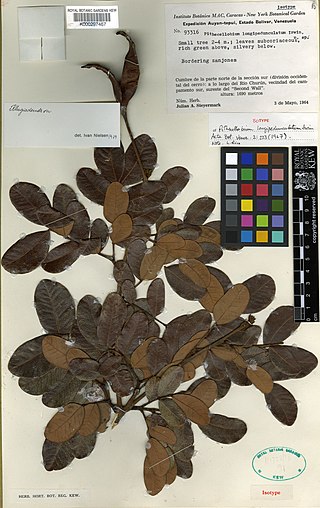
Abarema abbottii, the Abbott abarema, is a species of plant in the family Fabaceae. It is found only in the Dominican Republic, and is confined to broad-leaved woodlands on limestone soils.

Abarema cochliocarpos is a species of tree in the legume family, Fabaceae. Its common name is barbatimão. It is endemic to Brazil, where it occurs in Alagoas, Bahia, Paraíba, Pernambuco, Rio de Janeiro, Rio Grande do Norte and São Paulo.

Abarema filamentosa is a species of plant in the family Fabaceae. It is endemic to the Brazilian states of Bahia and Espírito Santo, and is found in lowland wet Atlantic Forest and restinga.
Abarema killipii is a species of plant in the family Fabaceae. It is found in Caldas Department, Colombia and on the eastern slope of the Ecuadorean Andes.

Abarema longipedunculata is a species of legume in the family Fabaceae. It is endemic to Bolívar, Venezuela.
Abarema obovata, the obovate abarema, is a species of plant in the family Fabaceae. It is endemic to the wooded hillsides of east and north-central Minas Gerais, Brazil.
Abarema turbinata is a species of plant in the family Fabaceae. It is found only along the coastal Atlantic Forest and restingas in Bahia, Brazil.
Pseudalbizzia berteroana, the Bertero albizia, is a species of plant in the family Fabaceae. It is found in Cuba, the Dominican Republic, Haiti, Jamaica, and Panama.
Hydrochorea acreana is a tree species in the legume family (Fabaceae). It is native to portions of Central and South America, including Nicaragua, Costa Rica, Colombia, Venezuela, Peru, and northern Brazil. Fruiting trees apparently have never been found.
Zygia cognata is a tree species in the legume family (Fabaceae). It is found in Belize, Guatemala, and Honduras.
Senna domingensis is a flowering plant species in the legume family (Fabaceae). It is a threatened species, found in Cuba, the Dominican Republic, and Haiti.

Libidibia monosperma is a species of legume in the family Fabaceae, with the common names cóbana negra and cóbana polisandro. It is found in the Dominican Republic, Puerto Rico, and the United States Virgin Islands. It is a federally listed threatened species of the United States.

Archidendron bigeminum is a tree species in the legume family (Fabaceae). It is found in India and Sri Lanka. It is known as "kalitiya - කලටිය" in Sinhala.
Abarema cochleata var. moniliformis is a vulnerable variety of legume which is endemic to the forests of Manaus, Brazil.
Abarema curvicarpa var. rodriguesii is a vulnerable variety of legume, known only from the Adolfo Ducke Forest Reserve near Manaus in Brazil.
Abarema leucophylla var. vaupesensis is a vulnerable variety of legume. It is restricted to an area along the Vaupés River and Apaporís River in Vaupés Department, Colombia.

Abarema adenophora is a species of plant in the family Fabaceae. It is native to Northern South America, Costa Rica, and Nicaragua.
Abarema alexandri is a species of plant of the genus Abarema in the family Fabaceae. It is endemic to Jamaica, where it can be found in woodland or thicket on limestone soils.
Abarema curvicarpa is a species of plant of the genus Abarema in the family Fabaceae. It can be found in Brazil, French Guiana, Guyana and Suriname.
Abarema alexandri var. troyana is a variety of the legume A. alexandri in the family Fabaceae. It is endemic to Jamaica, where it can be found in woodland or thicket on limestone soils.







